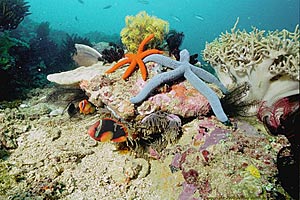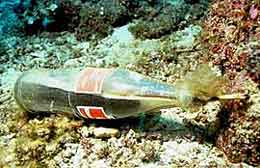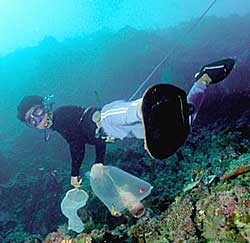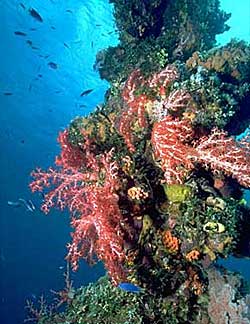|
(Source: *CORAL REEF PROTECTION: U.S. EPA; Viles and Spencer, 1995) |

Photo courtesy of Eugene Weber,
California Academy of Sciences
Montastrea cavernosa
Great Star Coral
|
Corals are comprised of colonies of tiny animals called polyps,
which belong to the phylum Cnidaria.
Each polyp resembles a small sea anemone and uses its stinging tentacles
to paralyze and feed on plankton. Polyps
secrete calcium carbonate, which forms the skeleton of coral and
the framework of coral reefs.
Corals have a symbiotic relationship
with microscopic algae called zooxanthellae
that live inside each polyp. Zooxanthellae are photosynthetic,and
produce foodstuffs which can be consumed by the polyps. In return,
the polyps provides a secure environment for the zooxanthellae and nutrients such as nitrogen.
(Colored terms are defined in the Glossary)
|
Top of page
|
(Source: *CORAL REEF PROTECTION: U.S. EPA; Viles and Spencer, 1995) |
|
Coral reefs have existed for approximately 450 million years and
are one of the most diverse ecosystems in the world. These "rainforests
of the oceans" are home to a wide variety of marine organisms.
Coral reefs require tropical or sub-tropical temperatures, and
are found between 30 degrees north and 30 degrees south of the equator.
They occur in shallow, clear water where light is sufficient to
support photosynthesis by the zooxanthellae..
The basic structure of the reef is one of building blocks - the
corals - and cement which is of provided by coralline
algae, bryozoans and encrusting
sponges. It is a highly porous structure.
|

Photo used with permission from
Jeffrey Jeffords
A portion of the coral reef community.
|
Top of page
Benefits of coral reefs to humans
include food,
coastal protection, medicine, and recreation.
|
| Food |
- Coral reefs support vast fisheries that coastal communities
depend upon. For example, in the Philippines, coral reef fisheries
provide approximately US$ 1 billion annually to the country's
economy and are a source of work for more than a million small-scale
fishers (White et al., 2000).
|
| Coastal Protection |
- Coral reefs provide natural barriers that protect coastlines from tides,
storms and hurricanes. They dissipate the wave energy and decrease the destructive stress upon
the coast (Sorokin, 1993). In 1991 there were an estimated 100,000 deaths as a result of a severe tropical storm in the
Bay of Bengal, which does not have any natural barriers to shelter the surrounding coastal area (Viles and Spencer, 1995).
|
| Medicine |
Two examples:
- Scientists in California developed a potent pain-killing drug from the toxin
of a reef-dwelling snail; it is used for the treatment of severe pain in the terminally ill who are resistant to morphine (*DOCTOR'S GUIDE;
*NEUREX CORPORATION).
- Coral skeletons are being used as bone substitutes in reconstruction bone surgery (White, 1997).
|
| Recreation and Profit |
- The diving industry has become a booming part of the tourism business and supports
many coastal communities all over the world. In the early nineties the number of divers carried by
one German charter airline alone was generating approximately 25% of the Maldives' GNP (Van Treeck, 1998).
|
Top of page
 Photo used with permission from
Jeffrey Jeffords
Photo used with permission from
Jeffrey Jeffords
A homemade explosive used for blast fishing
|
Dynamite or blast fishing is a practice in which fishermen use
explosives to kill and harvest fish.Although it is illegal, it is
practiced in forty countries worldwide and is a major threat to
coral reefs (McManus et al., 1997).
The explosion kills all fish within the blast radius and destroys
living coral. An explosive the size of a coke bottle will shatter
all stony corals within a three metre radius. Repetitive blasting
in an area reduces coral to rubble, which cannot support marine
life.
It takes 40 or more years for a dynamited reef to recover
50% of hard coral cover (Salvat, 1987).
|
Top of page
Approximately 70% of the fish
captured for the aquarium industry
have been captured using cyanide (McManus et al., 1997)
|
|
It is estimated that over 1 million kilograms of cyanide have been
used on Philippine reefs since that practice began, in the 1960s.
It is now an even greater problem in the Indonesian archipelago.
Cyanide is used to capture fish live for aquariums and even "live
fish" for restaurants. Divers squirt a cyanide solution from bottles
directly onto fish resting on corals, killing the corals and stunning
the fish. The fish often escape into crevices and the divers may
break apart the coral to get to their paralyzed prey (*BLAST AND
CYANIDE FISHING; Simpson 2001).
Steps in cyanide damage of corals
(Simpson, 2001):
- Cyanide impairs functioning of the zooxanthellae
- The zooxanthellae are discharged in a process known as coral bleaching.
- The coral polyps are then unable to survive because of lack of nutrients .
|
 Photo used with permission from
Photo used with permission from
Jeffrey Jeffords
A young boy fishing with cyanide on a reef
|
Short and long term losses
Half of the fish poisoned by cyanide die on the reef;
of the fish that survive, 40% die before
they reach the aquarium (Simpson, 2001).
A healthy coral reef can produce 20 tons or more of fish and other
edible products per square kilometre per year on a sustainable basis; a coral reef that has been destroyed by cyanide or dynamite fishing
can produce only 4 tons (White et al., 2000).
|
Top of page
Sewage flows into coastal waters raising the concentration of nutrients,
which leads to the rapid growth of algae in the water column and/or of seaweeds growing on the reefs. The algal growth reduces the sunlight available to zooxanthellae in coral polyps, and the corals die. This
process is a form of eutrophication.
Runoff of chemical fertilizers used in farming also results in eutrophication.
Kanehoe Bay on the island of Oahu is a good example of the effects of human runoff on coral reefs. For about
30 years Kanehoe Bay received
about 19 400 m3/day of sewage. A survey revealed that compared to earlier studies, 99.9% of the
corals in the heavily polluted area had been eliminated; the figure was 87% in leser polluted regions
(Salvat, 1987).
|
Top of page
The increasing popularity of scuba diving has put more strain on coral reefs
around the world. Divers frequently make contact with fragile corals, breaking them or
damaging their fragile tissue surface, leaving them susceptible to bacterial attack and disease (Rouphael and Inglis, 2001).
Boat anchors from dive boats also contribute to the damage caused by recreational diving.
Each time an anchor is dropped, 4-6 m2 of the reef surface
is destroyed (*THE CORAL REEF). |
Observations on damage to corals by underwater photographers
and recreational divers
( Rouphael and Inglis, 2001)
- 15% of divers damaged or broke corals
- 95% of damage occurred by fin kicks
- Divers without cameras averaged 0.3 breaks per 10 minutes
- Divers with cameras averaged 1.6 breaks per 10 minutes
|
Top of page
- Educate others about coral reefs and their importance
to future generations. Many people do not know corals are living
animals!
- Volunteer with a program aimed at preserving
coral reefs. Opportunities exist for recreational divers to conduct
participate in surveys of marine life with a variety of non-profit organizations.
Here are two of them
|
Top of page
- bryozoan
- A bryozoan is an aquatic invertebrate animal of the phylum Bryozoa that reproduces by budding.
Bryozoans often form moss like or branching colonies on the sea bottom or attached to seaweed.
(Source: adapted from *ENCARTA)
- Cnidaria
- The phylum Cnidaria consists of organisms that are characterized with
radially symmetrical bodies with saclike internal cavities, for example sea anemones, corals, and jellyfishes.
(Source: adapted from *ENCARTA)
- coral bleaching
- Coral bleaching is a response to stressful environmental conditions in corals in which they lose their colour.
It is caused when the zooxanthellae discharge out of their coral hosts. Some corals can recover from bleaching
by regaining their zooxanthellae, but others may die. The most common cause is an increase in water temperature but it
may also be caused by cyanide and other stressful conditions.
(Source: adapted from *ENCARTA)
- coralline algae
- Coralline algae come from the order Corallinales, which is an order of heavily calcified red algae that are exclusively marine.
Coralline algae are widespread in all of the world's oceans, where they often cover close to 100% of rocky substrata. Many are epiphytic (grow on other algae),
or epizoic (grow on animals), and some are even parasitic on other corallines.
(Source: adapted from *BOTANY DEPARTMENT AT THE UNIVERSITY OF THE WESTERN CAPE)
- eutrophication
- The process by which a body of water becomes rich in dissolved nutrients,
thereby encouraging the growth and decomposition of oxygen-depleting plant life and
resulting in harm to other organisms. The problem occurs in freshwater lakes or shallow
seas when human sewage or nitrates and phosphates from fertilizers drain into them.
(Source: verbatim from *ENCARTA)
- plankton
- A mass of small or microscopic organisms, including
algae and protozoans, that float or drift in fresh or salt water, especially
at or near the surface, and serve as food for fish and other aquatic organisms.
(Source: adapted from *ENCARTA)
- polyp
- Corals are made up of colonies of polyps. Corals secrete calcium carbonate which forms skeletal cups to
which the polyps are anchored and into which they withdraw for protection. Each individual polyp has a flattened oral
disc with an opening that is edged with feathery tentacles and cilia, that is both mouth and anus. At night the tentacles
extend from the cup, seize animal plankton and carry the food to the mouth. Stinging cells, or nematocysts, on the tentacles can also paralyze prey.
(Source: adapted from *ENCARTA)
- symbiotic relationship
- A close association of animals or plants of different species that is often,
but not always, of mutual benefit. The relationship between a cleaner shrimp and a fish on which it eats
parasites and food scraps is an example of a symbiotic relationship.
(Source: adapted from *ENCARTA)
- zooxanthallae
- Zooxanthallae are symbiotic unicellular yellow-green algae. They provide coral with
oxygen and some organic compounds they produce through photosynthesis.
(Source: Generic)
|
Top of page
- CORAL REEF PROTECTION: U.S. EPA
(http://www.epa.gov/owow/oceans/coral/)
United States Environmental Protection Agency, Maint.
(Rev. 2002, April 4; Viewed 24 Apr. 2002)
- This website highlights current initiatives and activities
in coral reef conservation.
- CORDIO: CORAL REEF DEGRADATION IN THE INDIAN OCEAN
(http://www.cordio.org/)
Sida, The World Bank, FRN, MISTRA, WWF, Spons,
(Viewed 28 Apr. 2002)
- CORDIO is a program that was initiated following the
extensive bleaching and mortality of corals that occurred
during 1998. This website provides information on the assessment
of the extent of damage, socio-economic effects, mitigation
and recovery.
- CRC REEF RESEARCH CENTRE
(http://www.reef.crc.org.au/)
CRC Reef Research Centre Ltd., Maint.
(Viewed 28 Apr. 2002)
- The CRC Reef Research Centre Ltd is a "knowledge-based
partnership of coral reef managers, researchers and industry."
Their website provides a reference for current scientific
publications relating to coral reefs, information on current
research programs as well as an overview of the Great Barrier
Reef ecosystem.
- INTERNATIONAL CORAL REEF ACTION NETWORK
(http://www.icran.org/)
United Nations Foundation, Spons
(Viewed 29 Apr. 2002)
- The International Coral Reef Action Network (ICRAN), established in 2000, is a global
partnership of coral reef experts who are working to halt and reverse the decline of the health
of the world's coral reefs. The website provides information on their stategic plans as well as
summary and progress reports.
- INTERNATIONAL CORAL REEF INITIATIVE
(http://www.environnement.gouv.fr/icri/index.html)
Ministère de l'Aménagement du Territoire et de l'Environment, IFRECOR, Spons.
(Viewed 28 Apr. 2002)
- ICRI is a unique environmental partnership that brings together countries with the objective of sustainable use and conservation of coral reefs for future generations.
This website provides information on the problems facing coral reefs and responses to these problems.
- INTERNATIONAL MARINELIFE ALLIANCE
(http://www.marine.org/home_page.html)
International Marinelife Alliance, Maint.
(Viewed 28 Apr. 2002)
- This website focuses its attention on mitigating three particular threats to the coral reef ecosystems of Southeast Asia and the Pacific:
destructive fishing practices, habitat destruction and overfishing. It provides information on public awareness programs and coral reef conservation programs
in Southeast Asia and the Pacific Islands.
|
Top of page
- Hodgson, G. 1999. A Global assessment of human effects on coral reefs.
Marine Pollution Bulletin 38: 345-355. http://www.elsevier.nl/inca/publications/store/4/0/0/
- McCook, L.J., J. Jompa and G. Diaz-Pulido. 2001. Competition between corals and algae
on coral reefs: a review of evidence and mechanisms. Coral Reefs 19: 400-417. http://link.springer.de/link/service/journals/00338/
- McManus, J.W., R.B. Reyes Jr., and C.L. Nañola Jr. 1997. Effects of some destructive
fishing methods on coral cover and potential rates of recovery. Journal of Environmental Management 21: 68-78. http://www.academicpress.com/jem
- Rouphael, A.B. and G.J. Inglis. 2001. "Take only photographs and leave only footprints"?: an
experimental study of the impacts of underwater photographers on coral reef dive sites. Biological
Conservation 100: 281-287. http://www.elsevier.com/locate/biocon
- Salvat, B. 1987. Human impacts on coral reefs: facts and recommendations.
Antenne de Tahiti Muséum E.P.H.E., Moorea, Polynésie française. Novanet: Dal. Lib. QH 541.5
C7 H84
- Simpson, S. 2001. Fishy business. Scientific American 285: 83-89. http://www.sciam.com/
This article provides information on cyanide fishing and how it affects coral reefs.
- Sorokin, Y.I. 1993. Coral reef ecology. Springer-Verlag, New York. QH 541.5 C7 S66
- Viles, H. and T. Spencer. 1995. Coral reefs. Coastal problems: geomorphology, ecology and society
at the coast. Edward Arnold, London, pp. 206-250. Novanet Call No. QH 541.5 C65 V55
- White, A.T., H.P. Vogt, and T. Arin. 2000. Philippine coral reefs under threat: the economic
losses caused by reef destruction. Marine Pollution Bulletin 40: 598-605. http://www.elsevier.nl/inca/publications/store/4/0/0/
|
Top of page
- AMBIO
(http://www.ambio.kva.se). Royal Swedish Academy of Science.
- BIOLOGICAL CONSERVATION
(http://www.elsevier.com/locate/biocon). Elsevier Science.
- CORAL REEFS
(http://link.springer.de/link/service/journals/00338/) Springer-Verlag.
- MARINE POLLUTION BULLETIN
(http://www.elsevier.nl/inca/publications/store/4/0/0/) Elsevier Science.
|
Top of page
- McManus, J.W., R.B. Reyes Jr., and C.L. Nañola Jr. 1997. Effects of some destructive
fishing methods on coral cover and potential rates of recovery. Journal of Environmental Management 21: 68-78. http://www.academicpress.com/jem
- Rouphael, A.B. and G.J. Inglis. 2001. "Take only photographs and leave only footprints"?: an
experimental study of the impacts of underwater photographers on coral reef dive sites. Biological
Conservation 100: 281-287. http://www.elsevier.com/locate/biocon
- Salvat, B. 1987. Human impacts on coral reefs: facts and recommendations.
Antenne de Tahiti Muséum E.P.H.E., Moorea, Polynésie française. Novanet: Dal. Lib. QH 541.5
C7 H84
- Sorokin, Y.I. 1993. Coral reef ecology. Springer-Verlag, New York. QH 541.5 C7 S66
- Simpson, S. 2001. Fishy business. Scientific American 285: 83-89. http://www.sciam.com/
- Van Treeck, P. and H. Schuhmmacher. 1998. Mass diving tourism - a new dimension calls
for new management approaches. Marine Pollution Bulletin 37: 499-504. http://www.elsevier.nl/inca/publications/store/4/0/0/
- Viles, H. and T. Spencer. 1995. Coral reefs. In: Coastal problems: geomorphology, ecology and society
at the coast. Edward Arnold, London, pp. 206-250. Novanet: Dal. Lib. QH 541.5 C65 V55
- White, A.T., H.P. Vogt, and T. Arin. 2000. Philippine coral reefs under threat: the economic
losses caused by reef destruction. Marine Pollution Bulletin 40: 598-605. http://www.elsevier.nl/inca/publications/store/4/0/0/
- White, E.W. 1997. Biomaterials innovation: it's a long road to the operating room.
Material Resources Innovations 1: 57-63.
- BLAST AND CYANIDE FISHING
(http://www.reefs.org/library/article/boulding_kirda.html)
Dean Boulding and Mike Kirda, Auth., Reefs.Org, Spons.
(Viewed 3 Mar. 2002)
- BOTANY DEPARTMENT AT THE UNIVERSITY OF THE WESTERN CAPE
(http://www.botany.uwc.ac.za/clines/)
D.W. Keats, Auth., University of the Western Cape, Maint.
(Rev. 2001 May 9; Viewed 29 Apr. 2002)
- CORAL REEF PROTECTION: U.S. EPA
(http://www.epa.gov/owow/oceans/coral/)
United States Environmental Protection Agency, Spons.
(Rev. 2002, April 4; Viewed 24 Apr. 2002)
- DOCTORS'S GUIDE
(http://www.pslgroup.com/dg/60d6.htm)
Doctor's Guide, Maint.
(Viewed 28 Apr. 2002)
- ENCARTA
(http://encarta.msn.com/)
Microsoft Corp., Maint.
(Viewed 29 Apr. 2002)
- NEUREX CORPORATION
(http://informagen.com/Resource_Informagen/Deprecated/2917.html)
Informagen, Spons.
(Viewed 26 Apr. 2002)
- THE CORAL REEF
(http://www.touregypt.net/parks/coral_reef.htm)
Tour Egypt, Spons.
(Viewed 28 Apr. 2002)
|
Top of page
|





